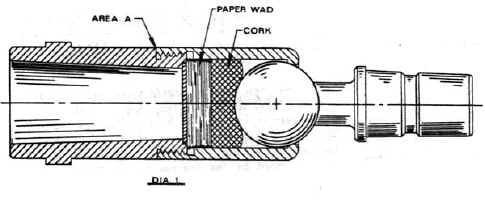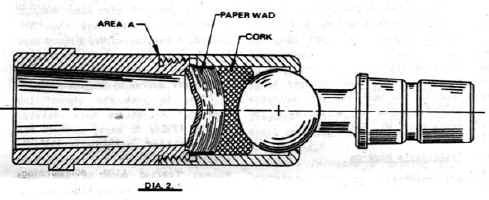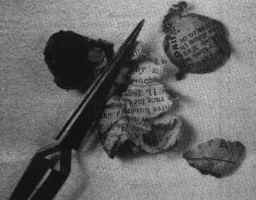|
 Article taken from "Backsights"
Magazine published by Surveyors Historical Society
Article taken from "Backsights"
Magazine published by Surveyors Historical Society
|
Theresa
Bannock and David St. John - April 1987
| Mr. T. R. Oden of New
Mexico and SHS member, provided a survey compass for restoration.
The instrument is engraved: "James Prentice, 66 Nassau St., New
York." Evidence exists which places the instrument in the
possession of Mr. William Pelham during the early surveys of New Mexico.
Certain facts have come to light about the dating of this instrument as
a result of this restoration project. |
Lower Portion
The staff adaptor of a surveyor's compass serves
the dual purpose of establishing a stable platform at a fixed elevation while
its articulating ball joint permits attachment of the compass plate assembly.
Stability is accomplished by loading the ball joint with a friction pad which is
compressed sufficiently to permit leveling and turning of the compass assembly.
Staff adaptors are, in general, the same from the period except for the external
configuration and, perhaps, the loading method used to secure stability.
In the case of this compass, the staff adaptor conforms to diagram 1.
 Disassembly
Problem Disassembly
Problem
Mr. Prentice demonstrated excellent threading
capability in the construction of his staff adaptor. Not only did the
thread configuration closely match present day standards for 60' thread form,
but the face cuts (Area "A"), at the time fabrication were such
that when assembled, the unit would have provided little evidence to the naked
eye as to how it had been produced. With the passage of time, normal field
use, and resultant surface damage, the mating surfaces became, for all intensive
purposes, invisible, even under the microscope.
Benchmark used Flouresence Microscopy in an
effort to determine if any parting line existed within the device so that proper
techniques could be used for disassembly. An area approximately 3/8"
wide was chemically treated the entire length of the housing to reduce
reflectance. A penetrant formulation of Ethylene Glycol, Glycerin, Ethyl
Alcohol and Flourescein was carefully applied and left overnight. The test
area was then viewed under low power with a microscope equipped with both long
and short wave ultraviolet illumination. Indeed, a parting line was found.
The next step was to modify a 5C soft
collect and bond a liner of "rulon", then bore an internal diameter to
match the outside of the staff housing to provide a firm, non-marring, high
friction clamping force to the assembly. A prudent application of torque
with a strap wrench then released the assembly which had been closed for over a
hundred years.
Establishing a Date
Dating an instrument can be difficult even when
certain verifiable clues and documentation exist. In this case, there is
sufficient supporting information to make safe an assumption that the instrument
was in the possession of William Pelham. One question arises. Was
this instrument used during early surveys of New Mexico, or, was it acquired by
Mr. Pelham at a later date? The puzzle seems to begin with Mr. Pelham's
arrival in Santa Fe during December of 1854 and the signature of Mr. Prentice on
the instrument -- and 66 Nassau St., New York -- which was not occupied by Mr.
Prentice until sometime in 1859. This conflict in dates essentially
negates the hopeful assumption that the instrument was used during the initial
survey of New Mexico.
A Simple Wad of Paper
Restoration can be a complex process.
Rigid guidelines are followed to determine appropriate technique. From the
very beginning, a diagnostic format is used to accumulate as much information as
possible before disassembly begins. In this case, several alternate
methods of disassembly could have been used. Each though, would have
contributed in some measure to the loss of historical information.
 Referring
to diagram 2, tension in this assembly was accomplished by a cork
friction pad backed by a number of layers of folded newspaper. This
combination was then compress against a brass disc. When the initial
tension released with wear and time, one had only to deform the disc from behind
to regain sufficient tension to maintain a stable platform for leveling.
When this assembly was opened, the wad of paper was seen to hold a legible text
of the period. Fortunately, one layer parted and provided a partial date
(t. 11, 1887), and some text. The remainder of the layers are fast held. Referring
to diagram 2, tension in this assembly was accomplished by a cork
friction pad backed by a number of layers of folded newspaper. This
combination was then compress against a brass disc. When the initial
tension released with wear and time, one had only to deform the disc from behind
to regain sufficient tension to maintain a stable platform for leveling.
When this assembly was opened, the wad of paper was seen to hold a legible text
of the period. Fortunately, one layer parted and provided a partial date
(t. 11, 1887), and some text. The remainder of the layers are fast held.
New Problem
 This
carefully folded wad of paper contains about 15-18 layers of news print and is
approximately 1/8" thick at the center. This collection of news print
has been subjected to pressure, friction, ambient environmental conditions and
microbiological activity for over one hundred years. As the cork slug
began to conform to the slope of the ball, so to, did the news print, with
attendant distortion. The objective at this point is to save as much of
the text as possible to enable more accurate dating of the instrument. It
is important to determine whether the newspaper was added by Mr. Pelham, or a
repairer, sometime after the instrument was in use, or by Mr. Prentice at the
time of fabrication. There is also the possibility that the instrument was
imported by Mr. Prentice with his name on it. The text will perhaps
disclose whether the newspaper was printed in New Mexico, New York, or England.
Such information will be important and provide direction for a more accurate
date of this compass. This
carefully folded wad of paper contains about 15-18 layers of news print and is
approximately 1/8" thick at the center. This collection of news print
has been subjected to pressure, friction, ambient environmental conditions and
microbiological activity for over one hundred years. As the cork slug
began to conform to the slope of the ball, so to, did the news print, with
attendant distortion. The objective at this point is to save as much of
the text as possible to enable more accurate dating of the instrument. It
is important to determine whether the newspaper was added by Mr. Pelham, or a
repairer, sometime after the instrument was in use, or by Mr. Prentice at the
time of fabrication. There is also the possibility that the instrument was
imported by Mr. Prentice with his name on it. The text will perhaps
disclose whether the newspaper was printed in New Mexico, New York, or England.
Such information will be important and provide direction for a more accurate
date of this compass.
Restoration at best is interesting work, but
labor is intensive and often tedious. As you might surmise, we were
visibly excited upon finding the wad of paper and understood its value as well
as the importance of selection and careful execution of proper technique.
If we are able to separate the individual pieces of newspaper and salvage the
text, the information will be photographed and then mounted and photocopied.
The original papers will be preserved and returned to the owner, Mr. Oden, along
with photocopies and photographic prints as part of the restoration project.
Present Status
We are currently awaiting a consensus opinion
from the American Institute for Conservation regarding the proper methodology
for saving the newsprint text. Until then, the materials will be stored in
a desiccator chamber with humidity held below the threshold of microbiological
activity. |
